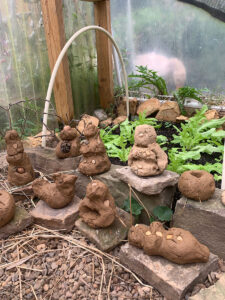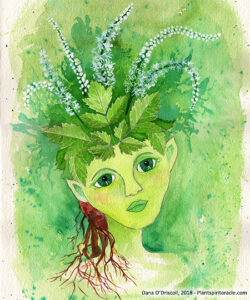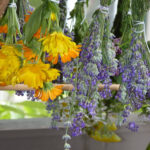I am hanging out with a friend’s two daughters by a local lake. The lake is peaceful early in the morning, and we are enjoying watching flock of wild geese playing nearby. One of the children picks up a beautiful, smooth stone and brings it over. “I’m going to take this home and put it in my fort!” She says. I ask “Does that stone want to go with you?” “Hmm…” she says, “I better ask.” I respond, “Great idea!” In the end, the stone is happy to join the foundation of her fort, and we go on our merry way. This whole interaction makes me smile–for if the stone is respected as a sovereign being, so too, are other things for this younger generation.
Over the last few months, I’ve begun talking about animism in relation to a worldview (ecocentrism), in relationship to co-creating intentions with nature, and in terms of weeding and clearing plants. In this new series, am planning on spending some time talking through animism as I understand it as a druid, and also in upcoming posts, connecting it to other practices such as permauclture, wild food foraging, gardening, and more. In today’s post, I’m going to break down some of the basic principles of animism as both a worldview and spiritual philosophy to lay the groundwork for more to come.
Defining Animism

Animism is a belief in the spirit of all things. Animistic views recognize that rivers, stones, trees, animals, human-created objects, and people all have spirits and that those spirits can be worked with, learned from, and honored in various ways. Historical evidence suggests that pre-holocene, it is likely that most peoples of the world held animistic philosophies; animism continues to be important to many indigenous people’s beliefs Animism is also an incredibly important movement in nature-based spiritual traditions like druidry and adjacent traditions. While specific forms of animism will vary based on the culture, there are some threads that seem to transcend across different animistic views.
Here are some common threads that define animism.
- Recognizing and honoring the spirits present in things present in the world and universe, both animate and inanimate, both natural and created
- Recognizing the importance of interacting in a respectful way with those spirits; building the right relationships and connections with them, and learning from them as teachers and guides
- Recognizing that humans are part of nature, like any other animal, and that we have a set of tools we have evolved, including both our five senses as well as instinct and intuition
- Recognizing that we have to cultivate our own intuition, observation, and listening skills (inner and outer) so that we might effectively communicate with the spirit present in all things.
- Recognizing that our actions have a significant impact on others and that we can engage in right actions to behave in ways that honor the sovereignty of all being
So under this philosophy not only does all living beings have spirit, but so does all of nature–including land forms and bodies of water. But also having spirit are all objects, all human-created things. If the world is literally full of spirit, there’s an incredible opportunity to interact, grow, and learn as part of that world.
Do all things have spirit?
From the above list, one of the big questions people ask is: what actually has a spirit? In the druid community, I see this question frequently. Some people believe that only all living beings have spirits, so that would include plants, insects, animals, fish, etc. Others believe that all of nature has spirit, which includes rivers, stones, mountains, etc. Where the division seems to occur is to whether human-created objects have spirit.

All things have spirit–and here’s the logic. Everything that exists–regardless if we are talking about an animal, a stone, or a human creation like your car or pair of shoes–comes from nature. In the natural world, we see that nature is the perfect recycler. A tree with spirit falls, and the worms and mushrooms with spirits decompose the tree, turning it into the soil. The soil web itself has spirit. Nutrients from that soil are taken up by plants, which are fed upon by animals–all with spirit. Thus, everything from natural cycles include spirit. If all nature has spirit, then things that are created from nature also have spirit. Humans also have spirit and come from nature. Thus, our creations that come from nature also have spirit–it’s the same process.
To break this down logically, we can say this: all things come from nature and have spirit. Things created in nature have spirit. Humans come from nature and have spirit. Things humans create come from nature and have spirit. Therefore, all things have spirit.
Let’s look at a few examples to clarify this.
Artistic tools and creations are one good example. As an artist, you can communicate with your tools, link with them, channel through them, honor them. My leather sewing machine, Coco, has such a strong spirit that she guides me when we sew together and she has her own music preferences she prefers to hear when we are sewing. I have no doubt about the spirit that resides within Coco. All of this art that I create with Coco, materials coming directly from nature, also has spirit. My paintings themselves, such as the Plant Spirit Oracle, are literally spirits that can communicate–they were intentionally painted that way. My experiences are hardly unique–many people who create anything and practice the bardic arts experience this–as do those experiencing others’ creations.
But what about industrialized creations? Stuff made in factories, maybe even without good environmental practices? The equation is the same–they are still made from nature, and if you accept that al natural things have spirit, then of course, these must have spirit too. They come from the world, they return to the world, and they have spirit. Now, even if all things have spirit, it doesn’t mean they have good energy–sometimes industrial creations are awful for many reasons, and that’s why we have cleansing practices in many spiritual traditions. But regardless of the energy that has gone into making these things, they still have spirit.
What about garbage or other throw-away things like single-use plastic? Yep, all of these have spirit because it comes through that same world and process as above. If you accept that single-use plastic has spirit, then it’s worth meditating on how you interact with things like unavoidable single-use plastic (perhaps create some ecobricks?) and other “trash.”
So what does this all mean? One of the key takeaways for me is that since I know everything in the world has spirit, it changes my relationships with things I interact with in the world. Those who hold an animistic philosophy can then work to interact ethically, spiritually, and honorably with all things in the world. Over time, Animism will radically change the view you have of the world and your place in it. If animism encompasses everything in the world, that philosophy implores you to take your animism out of the realm of the theoretical and into the realm of practice. And it is to this that we now turn.
How do I practice Animism? Animism in theory vs. Animism in Practice and Ethical Interactions

Once you’ve sorted out that all things have spirit, the next question is–what are you going to do with that knowledge? How does that change who you are, what you do, and how you interact with the living earth? These are important questions that may take you a lifetime of mediation and interaction to sort out–and that’s an amazing and sacred journey to take. Many who take up the practice of animism realize that embracing, living, and understanding this philosophy is a lifetime endeavor.
A critical next step is moving from philosophy to action. Beliefs in your head are easy enough to hold and think about–but it is actions where the core work of animism happens. That’s why I suggest that meditation and interaction with spirits as teachers and guides should be the basis for much of your own exploring of animism.
So let’s talk about some basic steps that you can engage in to turn animistic beliefs into actions.
1. Recognise that all things have spirit and all spirits have sovereignty. Think about this just like meeting an unknown human on the street. There are basic rules of engagement (eg. you aren’t going to start taking their hat, cutting their hair, touching them, etc). The rules for interacting with spirits are pretty much the same. This is particularly true when you are out and about in nature, but it is also true anywhere else, including in human-dominated spaces.
Sovereignty is the critical term here. Sovereignty refers to the authority of an individual to self-govern, in other words, the authority of an individual to make decisions that are best for themselves without others making decisions or inflicting their own actions/thoughts/opinions on them. If everything has a spirit, then we as human beings need to respect that that spirit is best to decide what should happen to them, and it’s not our place to override the will, agency, and choices of that spirit. This is a fundamental philosophy and I think one of the cores to embracing animism as a practice.
2. When interacting with any spirit, its important to honor the sovereignty of that being. To respect the sovereignty of spirits, don’t do anything without permission. When you see a flower you want to harvest, a stone you want to sit on, a tree you want to hug–just ask for permission and offer gratitude. Listen to what is said in return and honor whatever the spirit tells you. Doing anything else is a violation of trust. Sometimes it might be that an exchange can be made or sometimes you are tested and told no or to wait Just listen and trust in spirit. Nature will always work with you to meet your needs, but may want to meet your needs in a different way than you expect.
So let’s look at some examples here.
If you have access to land, or even if you want to do something new like put in a garden, take the time to co-create intentions with that land. Discuss your needs and the land’s needs and come to an agreement. This can become really useful if you can establish larger agreements that respect the sovereignty of the spirits of the land. For example, at the Druids Garden homestead, we have negotiated with the spirits of the land established areas for gardens and established areas for wild spaces. If we want to weed the garden, that’s fine, as there has already been an agreement in place about the use of that land and we don’t have to ask every plant if we can pull it out (although there is an agreement that all plants are used–either composted, made into medicine, etc).Thus, we can weed, harvest, and plant as we see fit. But if we wanted to establish a new garden or anything else somewhere else, we need to negotiate that and see how the spirits of the land feel about our request.
Another practice might be when you bring things into your home–groceries, new goods, books, whatever. Take a moment to connect with the spirit of those beings present. Honor them, acknowledge them, and be thankful for them. See what they may want (to be read, to be composted after use, to be used in a certain way). As a leatherworker, for example, when I purchase hides (especially online), I always lay out the hide on the floor of my art studio and open up a sacred space. I speak to the hide and ask the hide what it may want to be. Sometimes, some of my best artistic creations come from this experience.
When you need to release things from your life, thank them, honor their spirits, and do everything you can to ensure that they are recycled, rehomed, or given a new use. This honors both the spirit as well as what was given by the living earth or how the earth was harmed to make, produce, and ship that thing.
What does all of this do? It creates a powerful interaction between you and the world of spirit. It helps transition you from someone who takes from the land heedlessly, consumes, and is part of the problem to someone who is honoring nature in all her forms (including those forms where nature has been transformed into something else by humans) and putting you back into right relationship.
3. If you honor spirits, they will honor you and your relationship with nature will deepen tremendously. Flowing from the above, if you are engaging in these very respectful interactions with the spirits of nature, you are creating a circumstance where very deep work can happen. Nature takes you seriously. The spirits see that you are doing your best to rectify the unbalance that humans have, and they will respect you in turn for this.
A lot of people ask me–how do I deepen my relationship with nature? My first response is to spend as much time in nature as you can. And my second is to put yourself in right relationship with nature. If you only do these two things,

4. You are going to make a lot of mistakes, especially coming from Western culture. People from Western culture have been indoctrinated into an anthropocentric worldview that will take years–maybe decades–to overcome. Those of us from Western cultures have been socialized into seeing the whole world as devoid of spirit, that nature is there to fit their needs, and that they can do whatever they want without consequences. This is the legacy of colocalization, industrialization, and so many other issues whose time is now coming due. Even if you are the most conscientious and spiritually-minded individual, this socialization runs deep and it will take time to counter. Those of us working to recover from anthropocentrism (myself included) make mistakes, often. I’ll give you a good example–this summer, my goose flock and I have been going down to the swimming hole at the creek on our property for swimming each day. The geese love the water and cooling off, and I have been using that time for direct observation of nature, meditation, and ritual (as well as swimming ). As this has become a daily thing, I realized that a lot of the rocks in the creek between where we can go into the water and the 10 feet to the start of the swimming hole were hard for the geese to navigate. I was worried one of them might get injured. So, I took about 30 min and made a goose path through the creek to make it easier for the creek, moving the rocks out of the way in an area. Then I sat in meditation, and the creek was like, “you didn’t ask permission and you disrupted the ecosystem to do this.” And I was like “Yes, you are right. I just did this action and did not consult with you. I’m sorry, and I’m learning.” The creek accepted my apology and shared some ways to make my goose path better and less disruptive. It was a good lesson for me and a great example of how easy it is to forget to mind your manners.
5. Recognize that a lot of this is in the realm of the head, not the heart.
Everything I’m describing above is finding ways of making the philosophy of animism heart-based and experience-based, rather than head-based. Don’t get me wrong–there are some fabulous books out there about animism, but they are often from academic points of view (Harvey’s Animism being the one most people start with). There’s nothing wrong with reading about animism through the lense of social science, but fundamentally, being an animist is different than reading about being one.
So the action point here is to work to experience animism through your own direct experience, through your intuition (which is body-based), and through your heart. Feel the connection to the spirits. Talk with them, hear their stories. Recognize the joy that comes from building a relationship to them. See how it feels to interact–pay attention to the cues your body gives you when you meet a new spirit.
And most especially, quiet your own mind and listen. Make this a habituated practice–rather than imposing your own will and ideas on a place, object, or anything else, just take the time to listen to spirit. That listening is so critical as a first step and is a gateway into everything else.
6. Recognize that some spirits are teachers, guides, and companions. If you get to this point, and get through all of the above, then the real interesting spiritual work can begin. Spirits can be guides, teachers, friends, and companions. You can learn more from them than the best human teachers, and they can offer you deep insights. I’m going to spend a lot more time in an upcoming post in this series on how to learn from spirits.
Another way you might look at this is how polytheism vs. animism works. In polytheism, you might dedicate yourself to a single deity, small group, or pantheon. In Animism, you dedicate yourself to interacting with the world of spirit and develop a myriad of relationships through that practice.
7. Recognise also that not all spirits are friendly or have good intentions. Just like in the world of humans, spirits in the world have their own agenda. Nature is not always roses, puppies, and kittens. Part of the reason any spiritual tradition worth its salt teaches basic protective work as core/101 practice is that there’s a lot of stuff in the world of spirit that isn’t good and does not have good intentions. Don’t assume every spirit you interact with (including those in nature) is good. Some spirits who are friendly may also be tricksters or have their own agenda.
Conclusion
The practice of animism opens up literally an entire world of possibilities for interacting with the spirit inherent in everything. Through animism, you can connect deeply with the living earth and the natural world, but also within the human realms.



I took a course last year Animist Psychology and it altered my world view and deepened m sense of unity. Thanks for this offering.
Namaste,
Linda
PS I would like to reblog for my readers but there is no button. Do you permit reblogs?
Yes, you are welcome to reblog! I’m not sure where there isn’t a button on this new site…I’ll look into it :).
I look forward to this new series Dana! Animism was always the center of my worldview, from early childhood on. Your explanation with objects like cars made me giggle (in a good way) – I had this movie from Stephen King in mind, Christine, oh oh…
Greetings, Claudia
Haha yeah! I appreciate you reading and commenting.
Loved your post, I came via Linda’s reposting…. Indeed Spirit is in every thing… love your connection with our Earth Mother.. <3
Thank you, Sue! Thank you for reading :).
🙏
Thank you for this! I feel like this has really helped me view the world in a very different way (in the good sense)
Hello Nusrat, great I’m so glad to hear how much this has helped you. If you have questions that aren’t answered, please let me know!